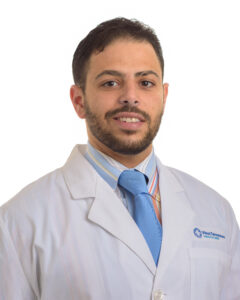When you bring home a new addition to your family, there’s a lot to consider. You’re concerned with keeping your newborn healthy and safe. One way to do that? Safe sleep practices to prevent SIDS.
Each year, nearly 3,500 babies in the United States die unexpectedly as they sleep, often due to sudden infant death syndrome, or SIDS. While that number has dipped since safe sleep practices were introduced in the early 1990s, any death is tragic.
But there are steps parents and other caregivers can take to reduce the risk of SIDS and other sleep-related deaths.
Michael Abdelmisseh, MD, pediatrician with West Tennessee Medical Group—or as he’s known to his patients, Dr. Michael—shares some guidance about how to keep your little one safe. Read on to learn more.

Understanding SIDS
While researchers still aren’t entirely certain what causes SIDS, there are some known risk factors. The National Institutes of Health shares that the risk of sleep-related death increases when babies:
- Sleep on their stomachs
- Sleep on a soft surface
- Sleep on or under soft or loose bedding
- Get overly hot as they sleep
- Are exposed to cigarette smoke either during pregnancy or after birth
- Sleep in an adult bed with others, including pets
The last risk factor is especially dangerous if the adult smokes or is intoxicated, if the baby is covered by a blanket, if there are more than two people in the bed, and if the baby is younger than 14 weeks of age.
Why is sleeping on the stomach so dangerous? Research seems to indicate that when babies sleep on their stomachs, it can block the airway, making it more difficult to breathe.
This also makes a phenomenon known as “rebreathing” more common—that means the baby is breathing in the air he or she breathed out. That causes the oxygen level in the body to drop and the carbon dioxide level to increase, which is a danger during sleep.
When rebreathing occurs, the brain usually sends signals to the baby’s body to wake up and cry, which gets more oxygen flowing. In cases of SIDS, the brain doesn’t trigger these signals and oxygen levels fall.
Keeping Babies Safe During Sleep
Even talking about SIDS can be scary. But there are steps you can take to keep your baby safe while sleeping:
- All infants younger than age 1 should be placed on their backs to sleep. The first—and most important—rule is to always follow the “Back to Sleep” guideline. This includes when you’re putting the child down for sleep at night and for naps during the day.
- If your baby is old enough to roll over during sleep, you don’t need to move him or her. When it comes to SIDS, it’s most important that babies start out sleeping on their back.
- You should position your baby for sleep on a firm and flat surface that’s covered by only a fitted sheet. There should be no other items in the sleep area, including crib bumpers, blankets, pillows, or stuffed animals. There are dual reasons for keeping the sleeping space free of objects. Doing so lowers the risk of SIDS, but it also helps prevent other serious issues, including entrapment and strangulation.
- It may sound counterintuitive, but even crib bumpers should not be used. There is no evidence they help prevent injury, but there is evidence they increase the risk of other health issues.
- How you dress your little one for sleep also matters. Because blankets should be avoided, you may want to choose a wearable blanket or other clothing that provides warmth when it’s cold outside. But watch for signs of overheating, including sweating or skin that feels hot to the touch.
- Swaddling is OK until the baby can roll over. If you choose to swaddle your baby, the American Academy of Pediatrics recommends ensuring the swaddle isn’t too tight and doesn’t constrict breathing in any way. When your little one begins to try to roll over, you should stop swaddling.
- Only bring your baby into your bed to feed or comfort. Bed-sharing is not recommended. If there is any chance you will fall asleep, leave the baby in his or her own crib or ensure there’s another adult present in the room who can take over care.
Jackson-Madison County General Hospital in Jackson is Safe Sleep Certified. The National Safe Sleep Hospital Certification Program recognizes hospitals that have committed to making babies as safe as possible in their sleep environments and eliminating as many sleep-related deaths as possible.
Have other questions about how to safely put your baby to sleep? Your pediatrician or another medical provider can offer you guidance on safe sleep practices, including what’s safe and what’s not.
Kids aren’t little adults! They have unique health needs, and a pediatrician or family medicine specialist can help provide the care they need. Michael Abdelmisseh, MD is accepting new patients. Schedule online today.
